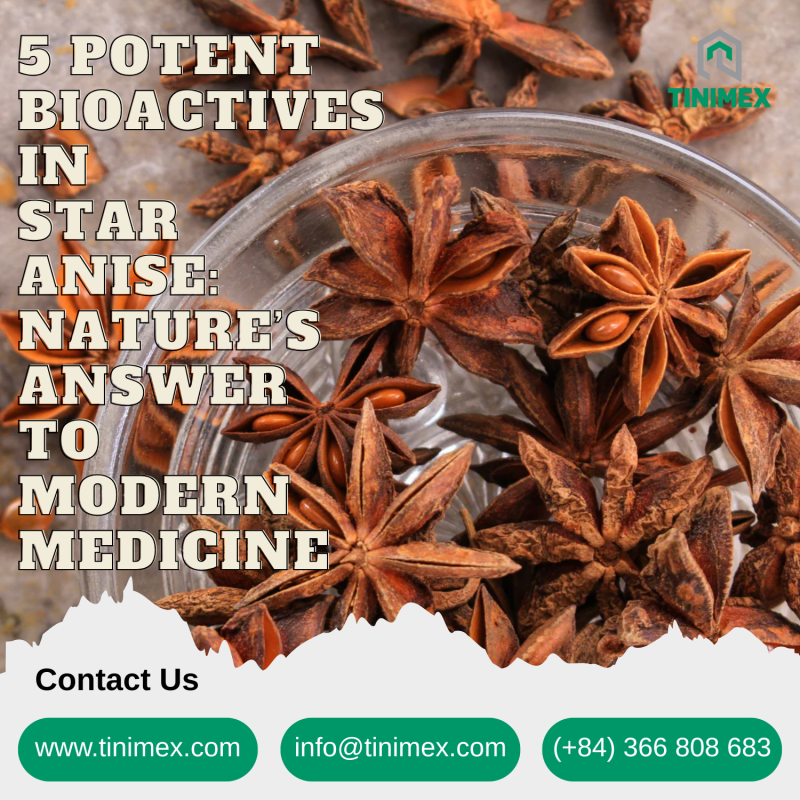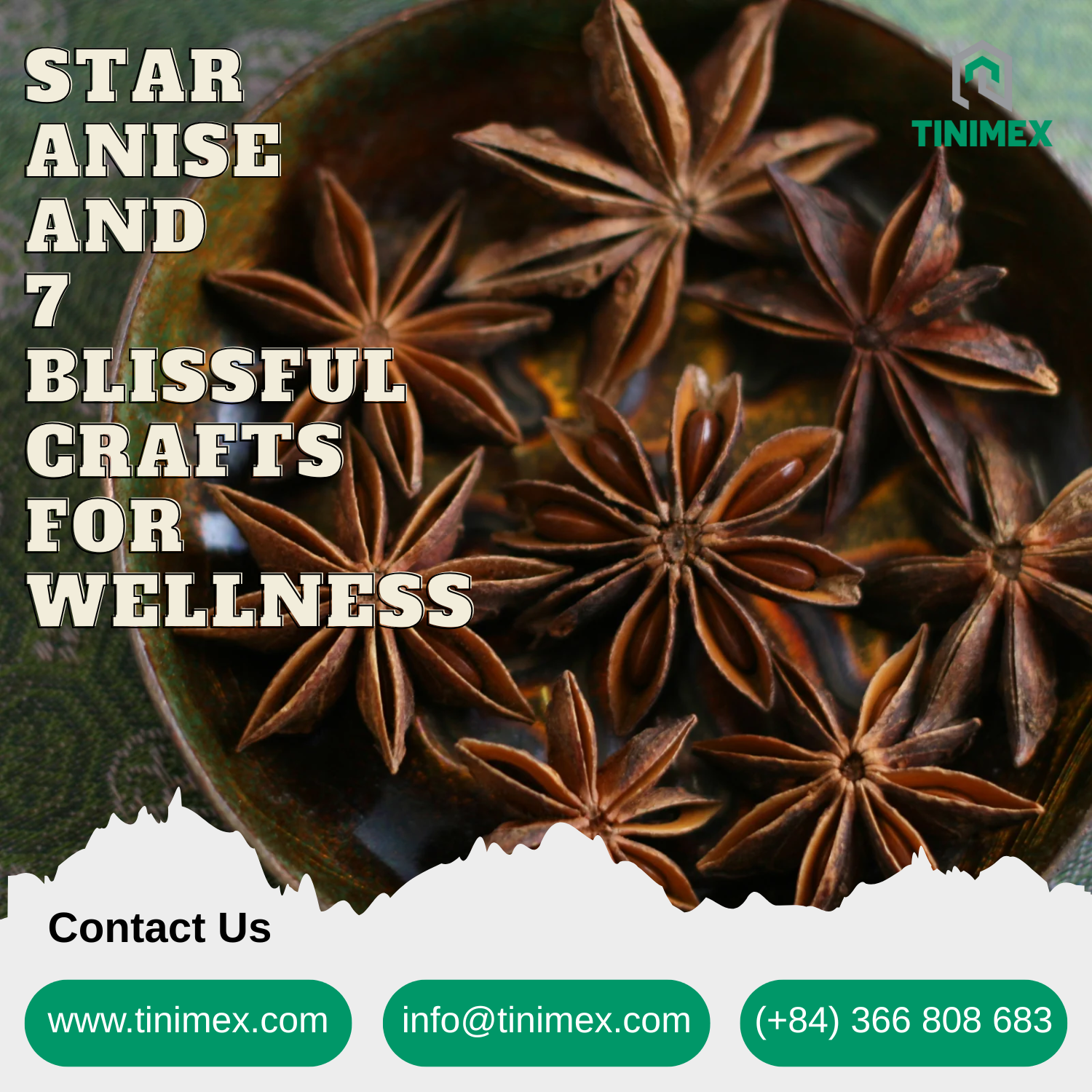5 Potent Bioactives in Star Anise: Nature’s Answer to Modern Medicine
Introduction: The Healing Power Within a Star
In a world increasingly shifting toward clean-label ingredients and holistic health solutions, the humble star anise (Illicium verum) has risen from a fragrant kitchen staple to a globally recognized medicinal marvel. Its distinctive star-shaped pods, often associated with culinary warmth and exotic spice blends, conceal a deeper secret: a complex arsenal of bioactive compounds with potent health-enhancing properties.
Native to the subtropical regions of Vietnam and China, star anise has been revered for centuries in traditional Eastern medicine. Yet today, its healing legacy is backed not only by cultural wisdom but also by rigorous modern science. Researchers across the fields of pharmacology, integrative medicine, and cosmetic innovation have begun to uncover the immense therapeutic value stored within its essential oils and phytochemical profile.
At the heart of star anise’s growing significance are a select group of five powerful bioactive constituents—natural chemicals that have proven abilities to fight viruses, reduce inflammation, stimulate immunity, and even enhance emotional well-being. From the production of life-saving antivirals to its use in stress-relief blends and natural skincare, star anise is more than a spice—it’s a botanical bridge between nature and next-generation medicine.
In this article, we’ll journey into the core of this remarkable plant by exploring five of its most impactful bioactive compounds. Each one plays a unique role in shaping the reputation of star anise as a plant-based solution to some of today’s most pressing health challenges. Let’s uncover how this star from nature is lighting the way forward in medicine, wellness, and beyond.

1. Shikimic Acid – The Antiviral Hero
Perhaps the most famous compound in star anise, shikimic acid is a critical precursor in the synthesis of oseltamivir—the active ingredient in Tamiflu, a leading antiviral medication. During pandemics like H1N1 and avian flu, demand for Tamiflu soared, drawing global attention to the importance of shikimic acid. In fact, up to 90% of the world’s commercial supply of shikimic acid is derived from star anise, cementing its role in pharmaceutical production.
- Pharmaceutical Demand: Shikimic acid’s value in antiviral drug manufacturing cannot be overstated. It is the foundation of a multi-billion-dollar industry focused on influenza treatment and prevention.
- Biosynthetic Importance: Beyond antiviral drugs, shikimic acid is a key intermediate in the biosynthesis of aromatic amino acids—molecules essential for plant survival and cellular health.
- Emerging Research: Recent studies suggest that shikimic acid may have potential applications beyond influenza, including antiviral activity against other pathogens and even roles in cancer therapy by influencing cellular functions.
The prominence of shikimic acid in star anise is a testament to the spice’s importance in both modern medicine and natural wellness, making it a cornerstone of pandemic preparedness and pharmaceutical innovation.
2. Trans-Anethole – The Fragrant Defender
The sweet, licorice-like aroma of star anise owes much of its signature scent to trans-anethole, a volatile compound that makes up 80–90% of the essential oil derived from the plant. But beyond its olfactory charm, trans-anethole is a pharmacologically active molecule that contributes meaningfully to both preventive health and therapeutic care.
-
Antimicrobial Properties: Trans-anethole has demonstrated strong antibacterial and antifungal activity against a range of pathogens, including Staphylococcus aureus, Escherichia coli, and Candida albicans. These properties make it a valuable ingredient in herbal remedies for infections, and a natural alternative to synthetic preservatives in food and cosmetics.
-
Digestive Aid: In traditional medicine systems, trans-anethole-rich extracts have long been used to support digestion. Modern research supports its role in stimulating gastric juice secretion, relieving intestinal spasms, and easing symptoms of indigestion, gas, and bloating. It also has carminative effects, meaning it helps expel gas from the digestive tract and soothes abdominal discomfort.
-
Skin Benefits: Thanks to its antioxidant and anti-inflammatory activity, trans-anethole is increasingly popular in natural skincare formulations. It helps protect the skin from oxidative stress, fights acne-causing bacteria, and promotes a clearer, more youthful complexion. Its gentle nature also makes it suitable for sensitive skin types when diluted properly.
-
Neurological and Hormonal Support: Recent studies suggest that trans-anethole may exhibit estrogen-like activity, which could have implications for hormone balance and menopausal support—though more research is needed. Additionally, its mild sedative effects have sparked interest in its use in calming essential oil blends for anxiety and sleep improvement.
This dynamic compound is now a staple in aromatherapy, cosmetics, oral care, and even phytopharmaceuticals, proving that what smells good can also heal deeply. With its potent therapeutic versatility, trans-anethole stands out as both a sensory delight and a bioactive workhorse in the star anise arsenal.
3. Linalool – The Calming Agent
- Anxiolytic Effects: Linalool interacts with neurotransmitters in the brain to promote calmness, reduce anxiety, and support better sleep.
- Anti-Inflammatory Action: It has shown efficacy in reducing inflammation and relieving pain in clinical studies.
- Use in Aromatherapy: Commonly used in essential oil blends to ease stress and elevate mood.
Linalool’s presence adds emotional and mental wellness to star anise’s list of benefits, making it a holistic healing agent.
4. Quercetin – The Cellular Guardian
The trace presence of quercetin in star anise may seem insignificant, but this potent flavonoid is a powerhouse of cellular protection. Widely recognized for its antioxidant capacity, quercetin neutralizes free radicals—unstable molecules that cause cellular damage and accelerate aging. Beyond shielding cells from oxidative stress, quercetin exhibits strong anti-inflammatory effects by modulating key pathways like NF-κB, which plays a central role in immune responses.
- Immune Booster: Quercetin is more than just an antioxidant—it also enhances immune defense. Studies show that it can promote the activity of macrophages and lymphocytes, the body’s front-line defenders. Its antiviral properties are equally impressive, with research demonstrating its ability to inhibit viral replication, including viruses like influenza and coronaviruses.
- Cardiovascular Health: Quercetin supports heart health by improving endothelial function, reducing arterial stiffness, and lowering blood pressure. Its action in promoting nitric oxide production helps maintain vascular relaxation, while its anti-inflammatory effects protect blood vessels from oxidative damage.
- Anti-Allergy Agent: Known for its natural antihistamine properties, quercetin can mitigate allergic reactions by blocking the release of histamine. This makes it useful for alleviating symptoms of allergic rhinitis, such as itching, sneezing, and nasal congestion.
Though not unique to star anise, the presence of quercetin adds synergistic strength to the spice’s overall bioactivity, enhancing its antioxidant, anti-inflammatory, and immune-boosting effects.
5. Anisaldehyde – The Natural Preserver
A lesser-known yet significant compound, anisaldehyde is a fragrant molecule that gives star anise part of its characteristic sweet, warm aroma. But its value goes beyond its scent, making it a versatile bioactive component.
- Antimicrobial Agent: Anisaldehyde has demonstrated efficacy in inhibiting the growth of various pathogenic bacteria and fungi, making it a natural choice for herbal remedies targeting infections and a potential alternative to synthetic preservatives in cosmetic and personal care products.
- Natural Fragrance: Widely used in perfumery, anisaldehyde’s warm, sweet scent makes it a popular ingredient in natural fragrances, essential oils, and wellness products designed for calming aromatherapy.
- Preservative Role: Beyond its antimicrobial effects, anisaldehyde helps extend the shelf life of natural products by reducing microbial growth, making it valuable in food preservation and natural cosmetics.
Anisaldehyde is a reminder that even the lesser-known compounds in star anise can deliver significant health and wellness benefits, reinforcing the spice’s status as a multitasking botanical with applications in health, hygiene, and beauty.
Conclusion: Bioactive Brilliance from Nature’s Star
Star anise is not merely a spice—it is a storehouse of therapeutic bioactives with far-reaching implications for modern medicine and holistic wellness. From its role in combating viral pandemics to promoting emotional balance and preserving natural products, the five key compounds highlighted here showcase the plant’s versatility and potency.
These compounds—shikimic acid, trans-anethole, linalool, quercetin, and anisaldehyde—work synergistically to support immune function, reduce inflammation, protect against microbes, and nurture both physical and emotional well-being. Unlike synthetic pharmaceuticals that often target isolated symptoms, star anise’s bioactives offer a more integrative approach, working with the body’s natural systems to restore balance and health.
What makes star anise especially remarkable is its dual strength: ancient roots and modern relevance. Centuries-old traditions in Eastern medicine are now being validated by advanced pharmacological research, bridging the gap between folklore and clinical science. This convergence makes star anise a powerful example of how plant-based healing can shape the future of global health.
As consumers increasingly seek natural, clean-label alternatives to synthetic drugs and chemicals, ingredients like star anise are poised to lead the next wave of innovation in medicine, functional foods, and personal care. Its sustainability, bioefficacy, and safety profile further position it as a cornerstone in the development of natural health products that are as effective as they are environmentally responsible.
Looking ahead, continued scientific exploration may uncover even more therapeutic applications for this star-shaped botanical. From cancer research to neuroprotection, the journey of discovery is only just beginning. For formulators, researchers, and wellness advocates, star anise offers not just a promise, but a proven path—one where nature’s brilliance meets human innovation.
Our contact:
Dc: 4th Flr., 40 Ngo Gia Tu Str., Duc Giang Ward, Long Bien Dist., Ha Noi, Viet Nam
Hotline: (+84) 366 808 683
Mail: info@tinimex.com
Website: www.tinimex.com





